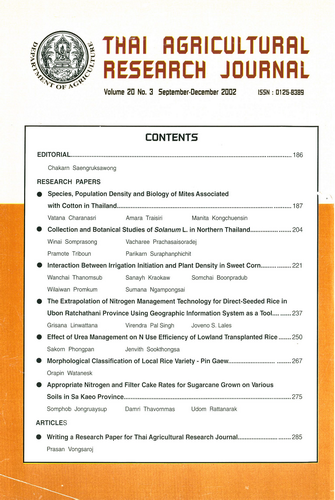Effect of Urea Management on N Use Efficiency of Lowland Transplanted Rice
DOI:
https://doi.org/10.14456/thaidoa-agres.2002.20Keywords:
urea, compost, ammonia volatilization, denitrification, nitrogen loss, 15N balance, lowland transplanted riceAbstract
A field experiment was conducted dduring the dry season of 1996 at the Suphan Buri rice experiment station in Central Thailand to determine the effect of urea (9.6 kg N per rai) broadcast shortly after transplanting either just pior to irrigation or following irrigation on grain yield and N use efficiency of lowland rice grown on a Phimai soil (Vertic Tropaquept) in the presence or absence of compost amendment (400 kg dry weight per rai). The results showed that N2+N2O emission was first detected with six days after urea broadcasting into floodwater. The cumulative emission of N2+N2O for both urea and urea + compost treatments represented 2.4 and 2.7% of applied N at 14 days following urea addition. The fertilizer N contribution to the cumulative NH volatilization at the end of 11 day sampling occurred 1.01 and 1.24 kg N per rai from the urea and urea + compost treatment which corresponded to 11 and 13% of applied N, respectively. Nitrogen-15 balance data at 56 days after urea application indicated that total fertilizer N recovered by plant (shoots + roots) and soil did not differ significantly between the urea and urea+compost treatment. Losses of N (unaccounted for) from the water - soil plant system were 25 and 27% of N applied for the corresponding treatments, respectively. Grain yield and N uptake in both grain and straw were significantly increased with urea over the control. Compost amendment did not change grain yield and N accumulation in rice. Urea broadcasting before or after irrigation did not show any grain yield and N uptake difference, regardless of source of urea and combination with compost.
Downloads
Published
How to Cite
Issue
Section
License

This work is licensed under a Creative Commons Attribution-NonCommercial-NoDerivatives 4.0 International License.
Thai Agricultural Research Journal



